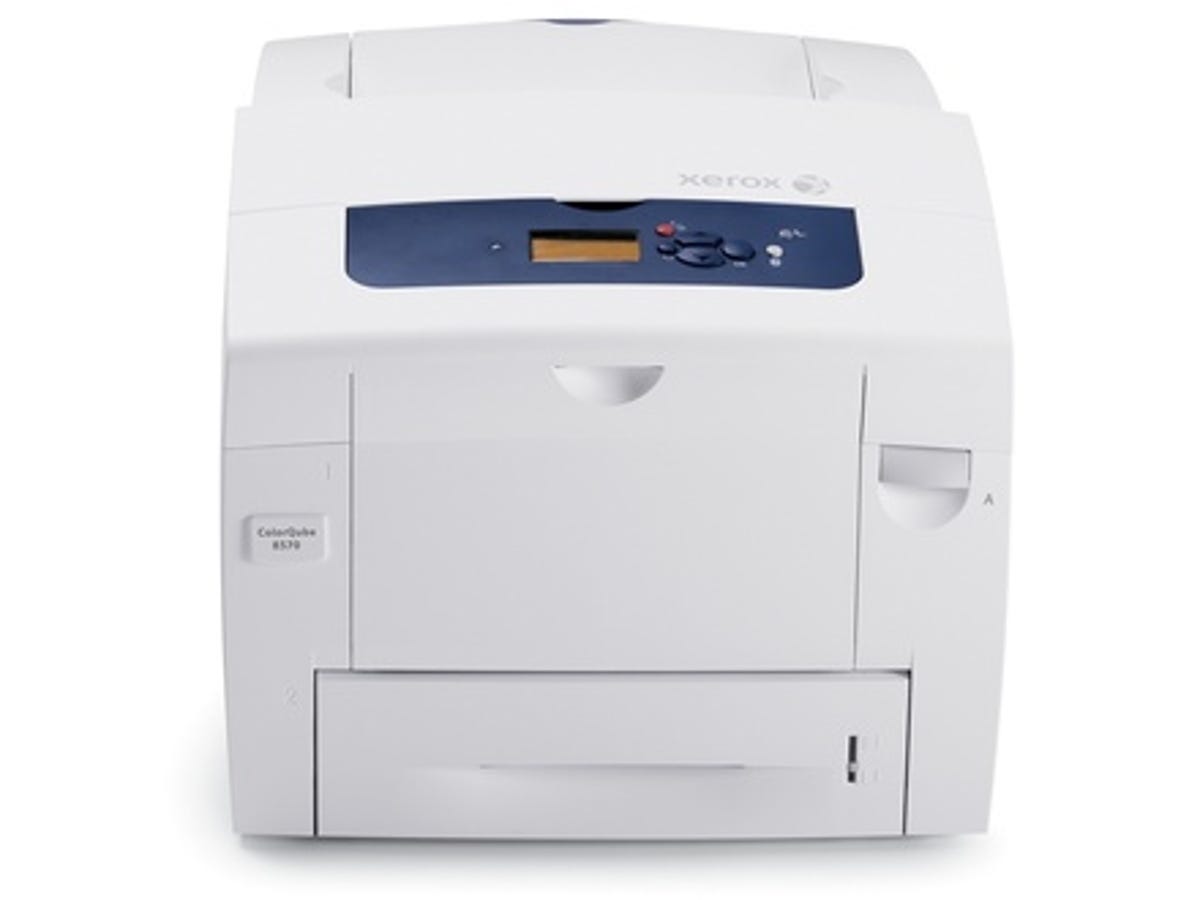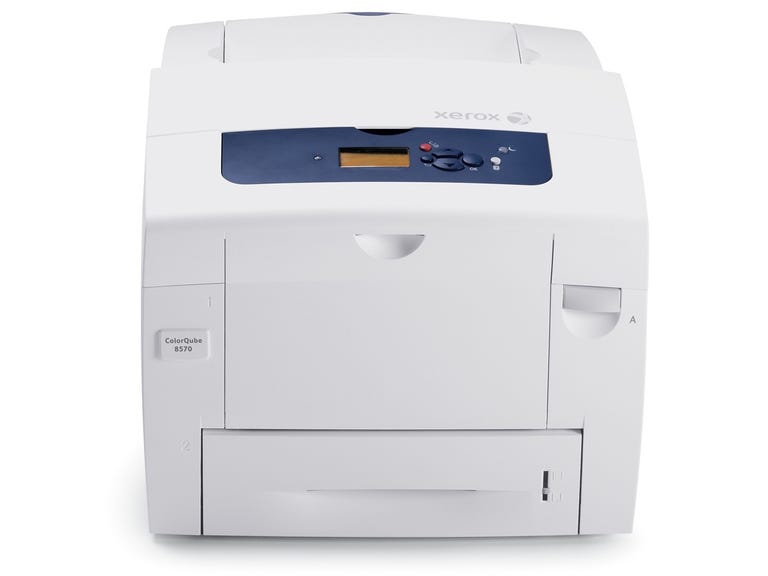 Why You Can Trust CNET
Why You Can Trust CNET Xerox ColorQube 8570 review: Xerox ColorQube 8570
The Xerox ColorQube 8570 can produce great-looking documents rapidly and is cheap to run but it's bulky, noisy and has a long warm-up time.
The ColorQube 8570 from Xerox doesn't use laser or inkjet technology. Instead it relies on a solid ink printing system. Chunks of ink are dropped into slots at the top of the printer and these are heated to melting point as and when the printer mechanism needs them.
The Good
The Bad
The Bottom Line
The results -- speed and print quality -- are close to laser technology. So just how well does this model, which costs around £400, compare to similarly priced laser printers?
Design
Like most of Xerox's current models, the 8570 has a two-tone colour scheme. White is used for most of the chassis, but the sloping panel on the front, which houses the screen and controls, is finished in dark blue. The contrast between the two colours looks quite stylish and is a change from the all-black designs of most of its rivals.
However, the 8570 is a big machine. It's almost twice as deep as most of the laser printers we've seen at this price.
The control panel has a small five-line monochrome display. There are six buttons next to it to help you navigate the various menus and to start or cancel print jobs. Menu navigation is slightly fiddly, but the layout of the menus is reasonably good, so you soon get the hang of it.
The main paper tray is positioned at the bottom of the machine and can take up to 525 sheets of paper. Above this is a multi-purpose tray that can handle another 100 sheets. You can add up to three more 500-sheet trays if you need extra capacity.
Sadly, there's no USB port for direct printing from memory keys and it lacks the secure printing feature that you'll find on rival laser models from the likes of Brother.

Installation
Before you can use the printer, you need to place the four solid blocks of ink into the body of the printer. To do this you pull open a panel on the surface of the paper output tray. Then place the ink blocks in the slots provided.
When you turn on the printer it takes a long time for these to be heated up to the required temperature. As a result, installation takes a lot longer than with a normal laser printer. It's worth bearing in mind that if you turn the printer off at night, it'll have to redo this warm-up phase each morning.
Also, if you're moving the printer you need to put it through a special power-down cycle, which gradually cools the inks. This takes around 30 minutes. If you move the printer before this cycle is competed there's a risk of damaging the print mechanism.
Once the warm-up cycle is complete, you can pop the installation disk in your computer and load the drivers and software. The machine supports Wi-Fi and Ethernet as well as USB, so you can either hook it into your network or just connect directly via a USB cable.
Speed, quality and cost
In terms of print speed, the 8570 is more than capable of taking on most laser models and even beating many of them on raw pace. It managed to produce our 10-page black and white text document in 43 seconds. A colour version of the same document took 38 seconds to produce. Our 10-page graphics document was completed in 48 seconds, while it took just 43 seconds to pump out our 10-page business presentation.
We've got no complaints about print quality. Text is dark and clean on the page, while colours are rich and vibrant, with pretty impressive colour accuracy. There is a slight waxy sheen to the ink, but a lot of people will actually find this an appealing effect.
However, there are a few quirks associated with the print engine that potential buyers should be aware of. The printer is very noisy when it's up and running -- much noisier than a laser model -- so it's probably going to be annoying to use in smaller offices. Also, solid ink has a slightly waxy consistency on the page and can actually be scraped off using a fingernail because it isn't fused as rigidly to the paper as laser toner.
Another slight issue is that you can’t run a sold ink printed page through a laser printer, as the heat process will damage the solid ink on the page. As a result, this model is not suitable for printing letterheads or other customised stationery.
The main benefit of the solid ink technology is low running costs -- something which is borne out on this model. Using the best prices we could find online for ink cubes, it works out at around 2.3p for a black and white page and 7.8p for a colour sheet. Those running costs are very competitive, especially on the colour printing front.
Conclusion
Overall, the 8570 is a decent option if you need to produce lots of colour sheets thanks to its fast print speed and low running costs.
However, some people may be put off by its rather long warm-up time. Solid ink technology seems to have more drawbacks than benefits for home office users.


